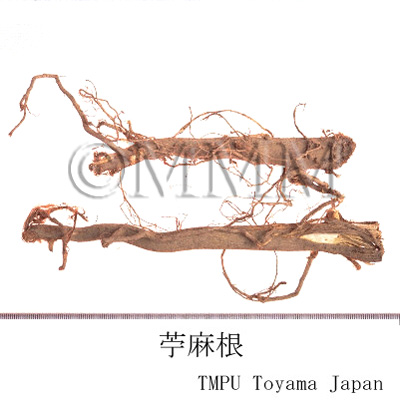※Click on the image to enlarge it.
| Common name | 苧麻根, Zhumagen, Boehmeriae Radix , Boehmeria Root |
|---|
| Synonyms | 苧麻 |
|---|
| crude drug image |  |  |
※Click on the image to enlarge it. |
|
|---|
| Original plant name | Boehmeria nivea (L.) Gaudichaud, (Nambankaramushi) |
|---|
| Family name | Urticaceae |
|---|
| Used part | root |
|---|
| Clinical application | As an antifebrile, diuretic, antidote and for preventing miscarriage, it is applied for oliguria, threatened abortion, hematochezia and abnormal uterine bleeding in pregnancy, sores, gonorrhea, hematuria, and erysipelas. |
|---|
| Medical system | Traditional Chinese medicine |
|---|
Drug effect in
traditional medicine | Traditional
classification | Hemostatics |
|---|
| Beneficial effect | To arrest bleeding by dispelling heat in blood, to clear the heat and prevent miscarriage, to promote diuresis, to clear away toxic material.: For hemoptysis, hematemesis, epistaxis, hematuria, abnormal uterine bleeding, threatened abortion, hematochezia and abnormal uterine bleeding in pregnancy, dark urine, gonorrhea, oliguria, toxic heat and sores, insect or snake bite. |
|---|
| Chemical constituent | Phenylpropanoids
(*C1):
Chlorogenic acid(葉/leaves )
Anthraquinones
(*C1):
Emodin, Physcion-8-beta-glucoside(以上根/roots)
Flavones & Flavonols
(*C1):
Rhoifolin, Apigenin-rhamnoglucoside(以上葉/leaves)
|
|---|
| Pharmacological effect | Not exactly known. |
|---|
| DNA sequence | AF062005, AF206870, AJ235801 |
|---|
Classical reference
(Chinese Herbal Classic "Zhenglei bencao") |  ※Click this image to see the actual image ※Click this image to see the actual image |
|---|
| Disease | Hemoptysis, Hematemesis, Hematuria, Irregular vaginal bleeding, Internal bleeding, Bleeding from trauma, Lower abdominal pain during pregnancy, Threatened abortion, Melena or hematochezia, Oliguria, Gonorrhea, Urodynia, Pyogenic dermatosis, Hemorrhoid, Snake bite, Urodynia |
|---|
| Formulation | rarely used in formula |
|---|
| References | C1)The Encyclopedia of Wakan-Yaku with Color Pictures Vol. I, pp 105-106. |
|---|
| Remarks | It is cultivated more commonly as a fiber plant than a medicine. |
|---|
| Last renewal date | 2020/11/20 |
|---|
| | |
|---|